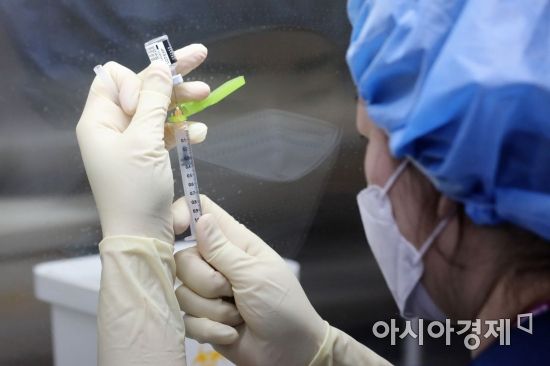Minimized waste volume with minimal residual syringe… The medical staff’s voice comes out

On the morning of the morning of the 27th, when the Pfizer vaccination for the treatment of COVID-19 patients began, medical staff are dispensing the Pfizer vaccine into syringes at a sterile workbench (Cleanbench) in the Central Vaccination Center at the National Central Medical Center in Jung-gu, Seoul. Reporter
[아시아경제 서소정 기자] The challenge of expanding the number of people vaccinated for corona vaccine by one or two per bottle with a special’minimum residual type syringe (LDS)’ developed by a domestic company is being attempted for the first time in Korea. The initial dose of AstraZeneca and Pfizer vaccines, which are currently inoculated, use a minimum residual syringe, but depending on the skill of the nurse, the amount of waste can be minimized and the number of inoculations can be maximized.
According to the Korea Centers for Disease Control and Prevention on the 28th, it is allowed to increase the number of vaccinations per bottle of the Corona 19 vaccine used in Korea by 1-2 at the site. If the amount of discarded vaccine is minimized by using the minimum residual syringe, the number of people vaccinated per bottle of Pfizer vaccine can increase from 6 to 7 and the number of people vaccinated for AstraZeneca vaccine can increase from 10 to 11 to 12.
In a briefing the day before, the head of the vaccination management team of the promotion team Chung Kyung-sil said, “depending on the skill level of the vaccination personnel, 6 people may not come out of one bottle of Pfizer vaccine, or more than 6 people may come out.” “I want to use the remaining amount.”
“However, the prescribed dose must be observed, and it is absolutely forbidden to collect and use the remaining amount from each bottle,” he said. “The remaining amount inoculation should be judged according to the site situation, and the residual amount inoculation itself is not mandatory.” Explained. The Corona 19 Vaccination Response Promotion Team announced on the 27th that it has distributed’how to conduct vaccinations’ with the same contents to the national sites.
The minimal residual type syringe is a special syringe designed with little space between the piston and the needle. Using this syringe can reduce the amount of waste and increase the number of inoculations per bottle. Currently, the number of vaccinations per bottle is 6 people with Pfizer vaccine and 10 people with AstraZeneca.

On the morning of the 26th, medical staff at the Geumcheon-gu public health center in Seoul contain a new coronavirus infection (Corona 19) and AstraZeneca (AZ) vaccine in a syringe.
According to the authorities, the Pfizer vaccine is made by mixing 1.8 ml of saline solution with 0.45 ml of undiluted solution, and 0.3 ml per person should be inoculated. AstraZeneca vaccine contains more than 5 ml of medicine in one bottle, and 0.5 ml per person is inoculated. If the number of inoculations per bottle of Pfizer increases from 6 to 7, the number of inoculations can be increased by 16.7% arithmetically. If the number of AstraZeneca vaccinations increases from 10 to 11-12, the number of vaccinations can increase by 10-20%.
The authorities have so far supplied 670,000 minimal residual syringes to inoculation institutions. Domestic manufacturers Doowon Meditech and Shin-A Yanghaeng supplied them, and Poonglim Pharmatech donated 127,000 to the government ahead of export to the United States.
However, opinions differ among experts. Eom Joong-sik, a professor of infectious medicine at Gachon University Gil Hospital, said, “Sufficient verification had to be done first for minimizing the residual amount and expanding the number of vaccinations,” he said.
Prof. Eom said, “Because it is something humans do when extracting drugs from a syringe, there may be some errors,” he said. “If the number of vaccinations per bottle of vaccine is increased, it is difficult to accurately determine the amount of the last vaccination, and there may be a shortage.”
Kim Woo-joo, a professor of infectious medicine at Korea University’s Guro Hospital, said, “There is a problem in urgently determining the residual amount treatment policy without expert deliberation.” I was concerned.
Reporter Seo So-jung [email protected]
